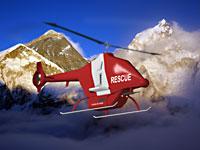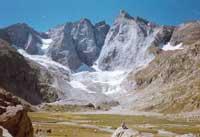Medical Research at the Everest Summit
2007/04/21 Galarraga Aiestaran, Ana - Elhuyar Zientzia
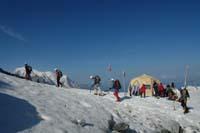
The Xtreme Everest expedition has medical goals. (Photo: Recent searches
The expedition, which departed from London on 17 March, will offer the whole month of April at the base camp, 5,300 meters high, conducting experiments. In addition to doctors, two hundred volunteers will perform tests and a small group of researchers set out to go to the top in May to do tests.
Although the expedition has a scientific purpose, it is somehow a spectacle. The BBC, for example, advances in autumn the issue of the documentary Xtreme Everest on the expedition. Meanwhile, almost live and through different channels (radio, television and Internet), it allows the tracking of the expedition. On the Internet, for example, before arriving at the base camp, some participants have already indicated that they have felt fatigue and respiratory distress.
But that is the objective of this expedition; being in the media will help to get money to carry out the expedition, but in reality they want to analyze the consequences of lack of oxygen and then find new ways of treatment for patients with lack of oxygen. And Everest is a perfect laboratory for measuring the impact of lack of oxygen.
Natural laboratory
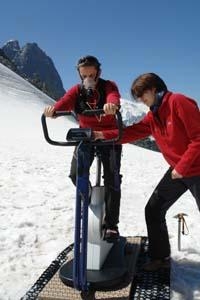
Measure the influence of height and physical exercise on the body. (Photo: Recent searches
As it ascends the mountain, the concentration of oxygen in the air at sea level is the same, 21%, but decreases the pressure and density of the atmosphere. This causes less oxygen to reach the lungs than at sea level. Because cells have less oxygen than necessary, there is a risk of hypoxia, that is, of serious circulatory, respiratory and brain problems.
Something similar happens with many intensive care patients. They are often given for lack of oxygen in the blood from one disease or another. Most of the expedition's doctors and nurses work in intensive care, so the changes they observe as Everest ascends will be analyzed with special care, as they hope to obtain beneficial conclusions for patients.
More than one may wonder why they don't do these tests in the lab. There are cameras that simulate at will an atmosphere poor in oxygen. However, according to the organizers of the expedition, it is more accurate and practical to do so in the field than in the laboratory.
On the one hand, the higher the number of participants in an experiment, the lower the error in the results. More than two hundred men and women of all ages participate in this expedition. Among them, nine boys and girls aged 6 to 13 will be in the base camp.
On the other hand, participants will spend several weeks on the mountain, and spending so much time in a camera is very difficult. However, expeditions have used such cameras to test respiratory devices, masks, meters and other instruments.
Special studies
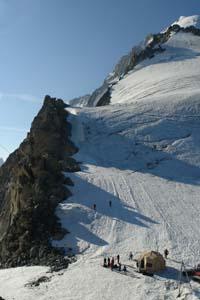
They will also perform medical examinations at the top of the OrEverest. (Photo: Recent searches
However, performing high altitude medical examinations is not as easy as doing at sea level. For example, expeditionaries want to measure the blood oxygen concentration at the top of Everest, but they know it won't be as easy as in the hospital.
At the top of the mountain, blood circulates at high pressure through the arteries of the thin wall, and with temperatures below zero and variable conditions, blood extraction is difficult and dangerous. Among others, there is a risk of thrombosis or bleeding. To avoid this, they will take special measures.
In the base camp it will not be so difficult to take blood samples. They will measure the oxygen concentration of volunteers in the tissues and arteries of different parts of the body to find out where the blood is going during exercise.
In addition to blood, the lungs will be studied. In fact, the appearance of pulmonary edema due to lack of oxygen is relatively frequent at high altitudes, if not treated early can lead to death. To analyze what remains, they will use an echocardiograph. This tool will visualize the blood flow of the heart and the main vessels that reach it, and investigate how it affects the lungs.
Of course, the brain will also be studied. For many, many of the symptoms of the disease at heights are caused by cerebral edema. By increasing the brain, it does not enter the skull, which causes a great headache, a loss of balance and finally death. Expedition physicians will measure intracranial pressure and use infrared spectrometry to study the oxygen level of the brain.
Finally, genetic studies will be conducted in search of genes that offer the advantage of staying in adverse conditions. In addition to the DNA of the mountaineers, they also want to investigate the DNA of the inhabitants of Tibet, to know what makes ‘hard’.
It is a great expedition, the intention too. Now only the results are as useful as expected.
Published in Gara.

Gai honi buruzko eduki gehiago
Elhuyarrek garatutako teknologia



